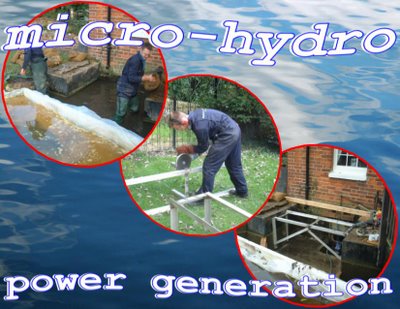
The Shape Of Things To Come
The good news is . . . . we've been successful in our bid and awarded one of the top grants in EDF Energy's Green Energy Fund by securing a grant of more than towards a micrhydropowerer generator to harness the rivers' energy which is match funded from Clear Skies, nearly £60,000.
The Green Energy Fund is generated by voluntary contributions from EDF Energy customers paying a green tariff matched by EDF Energy pound for pound. Thousands of EDF Energy customers have opted into the scheme and each pay about £15 per year towards renewable energy schemes. The fund encourages the generation of energy produced from sun, wind, water and other renewable sources, providing a cleaner alternative to fossil fuels such as coal, oil and gas. It also encourages innovative ways of reducing the greenhouse gases responsible for global warming.
At Crabble, our new micro turbine system is so state-of-the-art that it's only just been approved for use by government and leading agencies. Designed and purpose-built by Hydro Generation (our contractor), Phil says it will generate enough electricity to supply the equivalent of six average UK homes, making the Mill self-sufficient and potentially generating a surplus to sell back to the grid for other people to use. We are hoping it will provide power not only for all the Mill's requirements, but also for the envisaged development of the Mill Cottages too. It will save thousands of pounds on energy bills and cut the buildingÂs carbon emissions by more than 12 tonnes each year.
Peter Hofman, EDF Energy's Director Sustainable Future, said:
"This is an excellent project which will deliver real benefits for the environment. Visitors will see modern renewable energy technology working hand in hand with 19th century engineering.
"As one of the UK's largest energy companies we take our responsibilities to the environment extremely seriously. By funding projects such as this one we can help showcase renewable energy in action."
For me, a real serendipity is the most desired location to site our micro-turbine generators is within the tailrace of the older mill which was built on this site prior to our Crabble Mill, slap, bang, right where a waterwheel was situated of the more ancient Crabble Mill. It seems like it's just a natural up-grade to put a contemporary power-source where an historic power-source previously existed.
It also works very well that, included in the Project budget are funds sufficient to build an educational display panel to describe and interpret the system and incorporate the LCD constant read-outs of what power is being generated and what is being fed to (or taken from) the National Grid. This is truly going to be a live exhibit!
For anyone concerned about how much water the Project takes to generate this electricity, particularly in these times of drought. It takes less water than the amount we lose each and every day by the leak-pipe which drains-off from the Millpond by the road and discharges downstream of the waterwheel downstream of the bridge. That pipe kinda defeats the object of having a manmade millpond, dammed to retain water as an energy-tank. (Memo: "must get the leak fixed!")
Of course, we're working closely with the Environment Agency and the Planning authorities to meet all their requirements for the various licenses and permissions to be granted. If all goes well, we hope to start the installation within the next few weeks and have it completed before winter this year.
In preparation, there are things we can do to help keep installation costs to a minimum. One of the big messy jobs is to dig out all the shingle in the pit/ tailrace which was put in when we did the restoration (Sorry! We thought it was the best solution at the time!!) . . . . and get the gradient right for natural flow through the Mill into the by-pass. This will not only make way for installation works, it will also help the desilting of this otherwise smelly backwash. This will be a wet and mucky job and probably take a few people. If we can do it ourselves it will keep costs down so that more can be spent on the quality of the educational exhibit.
And the even more good news is . . . . anyone fancy joining me for a dirty weekend there soon? Now's your chance, it WILL make a difference, the more the merrier!! Do let Ant know if you can.
PART TWO : coming soon!!


